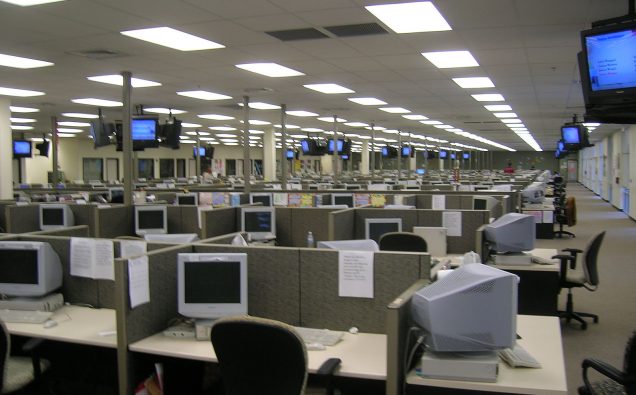
Image: A Call Center in Florida, Credit: Petiatil/Wikimedia Commons
Increasingly, organizations are turning to contact centers, as a way to drive competitive advantage, to create a systematic and a sustainable differentiator and to improve customer loyalty, repeat business and to grow market share.
A few years back business executives told us that they saw their call center as a necessary evil. In other words, we have all those pesky customers out there, and we don’t want them bothering our salespeople, our engineers, our R&D people, our marketing people. So, we’re going to put up this call center, and they are going to become a shield between the customers and us.
In other words, call centers were there to absorb all the questions that those customers might have. So the call center was viewed as a supplement to traditional brick-and-mortar facilities. The goal was customer satisfaction.
However, in the new paradigm which has emerged, in the last 3 to 5 years, the call center is increasingly being viewed as a source of value creation. It’s a way to differentiate your company’s products and services. It’s frequently considered as a replacement for traditional brick-and-mortar facilities.
Moreover, the goal often is not to react to the customer, but instead, to stay ahead of customer needs and expectations and ultimately, to create customer enthusiasm – and customer loyalty – and to differentiate your company’s products and services from those of the competition.
Although what you’re selling – regardless of whether it’s building materials or insurance services or any other products or services, to the extent that they might be viewed as a commodity, service or product – the call center has an opportunity to differentiate your products and services from those of the competition.
So, you can think about the service you deliver at the call center at the flipside of the product that you sell within your organization. They are two sides of the same coin. Moreover, in world-class service and support organizations, in world-class call centers, the two become indistinguishable. In other words, the service becomes part of the product. Moreover, high-quality service differentiates the product and drives repeat business, drives positive word-of-mouth referrals and drives customer loyalty.

A typical Call Center telephone Photo: Petiatil/Wikimedia Commons
Satisfied customers are not necessarily loyal customers. They don’t necessarily want to do business with you, and they are unlikely to propagate positive word-of-mouth referrals or be loyal to your channel.
By contrast, enthusiastic customers want to do business with you; they will propagate positive word-of-mouth referrals. So eager customers are the ones that are loyal to you and keep coming back and enable you to grow your business, increase your market share and improve your revenue. Now, what we’ve seen, over time, is that call centers tend to evolve through three stages.
Call centers that are relatively new or immature tend to operate in what we would call the support stage. These are reasonably reactive call centers. They are merely trying to keep the lid on service levels, but they are forever playing catch-up with customer needs and expectations. If you have ever worked in a call center like this, you know that these call centers tend to be somewhat chaotic.
However, in most cases, the call center will begin to recognize that there must be a better way to do things. So, they start to make investments in training and tools and technology that enable them to get ahead of customer needs and expectations and start to anticipate what the customers want and to begin to get more proactive about the quality of service that they deliver and the value of service that they provide through the contact center channel.
Finally, the most successful in this evolution become what we would consider strategic stage call centers. These are the call centers that operate in this new paradigm. They know that they can create value at this interface, they see that customer contact is a potential opportunity to create a competitive advantage. The goal is to stay ahead of customer needs and expectations and to drive loyalty, enthusiasm and to differentiate the company’s products and services.
Now, unfortunately, most call centers still operate in the support stage. They are not aware of the fact that they can potentially become more strategic, more proactive, more preventive and more of a value driver within the organization.
Now, nearly two-thirds, or 64% of call centers worldwide still operate in this support stage. That is, they are very reactive. However, about 31% – nearly one-third – have entered what we call the transitional or the growth stage, where they begin to make substantial investments in training and tools and technology, in an effort to drive value at this interface, in an effort to inspire loyalty and to create a competitive advantage through the call center.
Only about 5% worldwide operate in this strategic stage. Some organizations get there and then, lose their competitive advantage and then slip back into the transitional or the support stage.
So how can you make this transition quickly and efficiently? I have seen many failed attempts and few successful ones. What about you? What do you think works?















